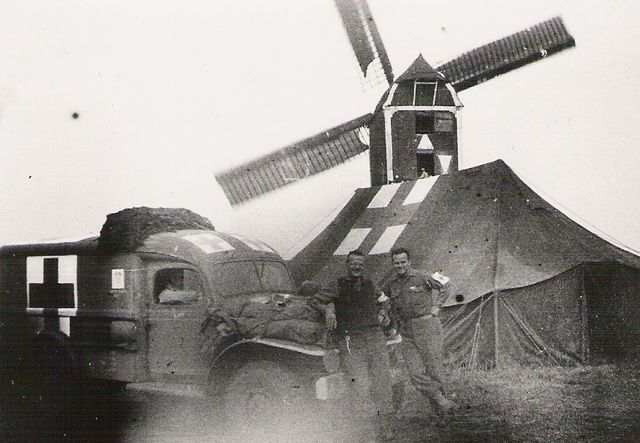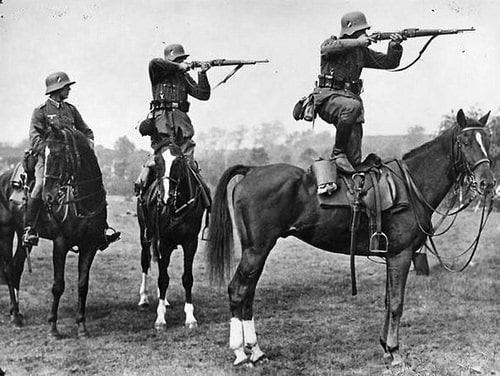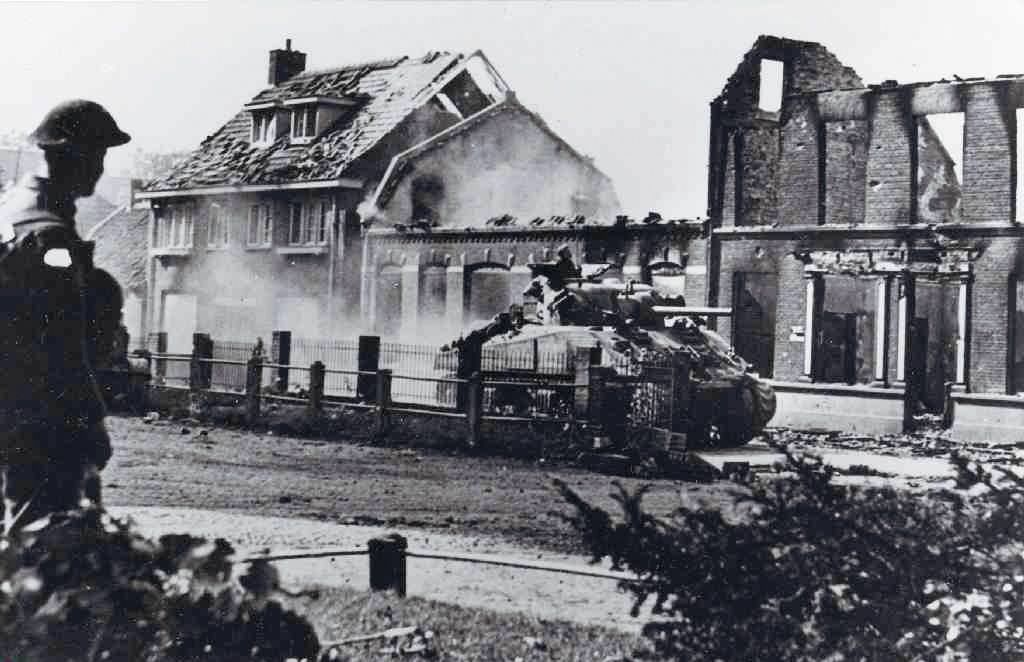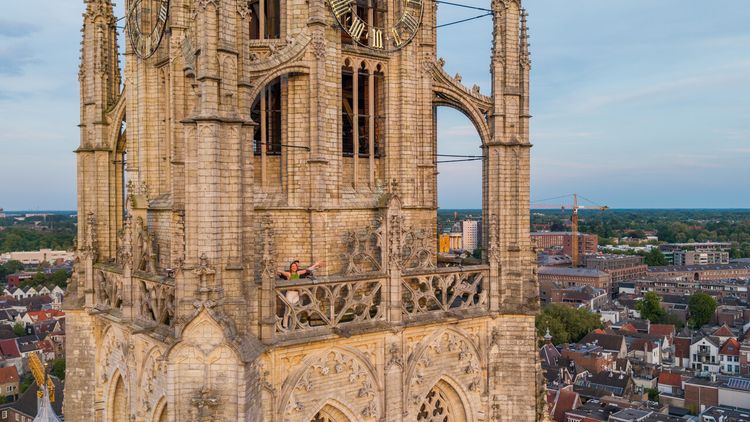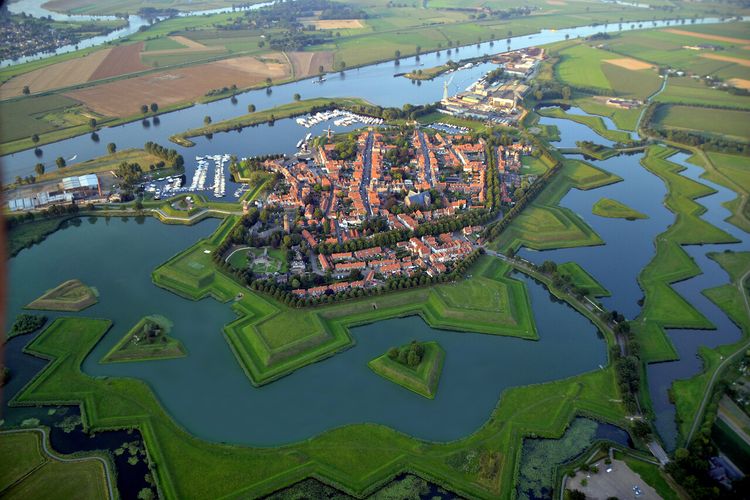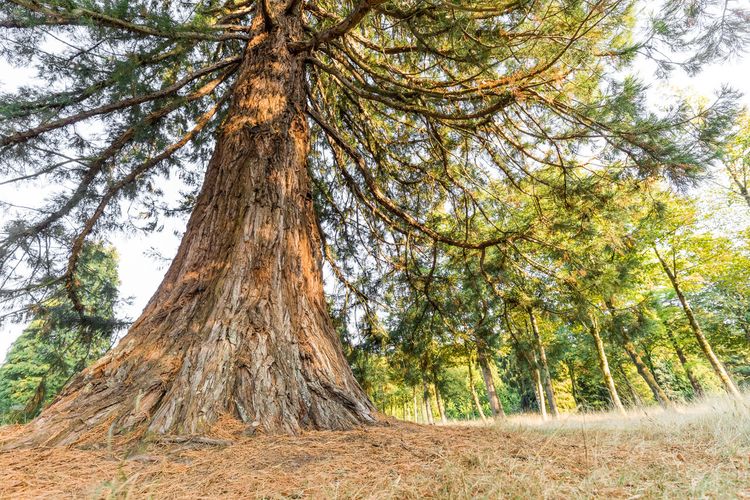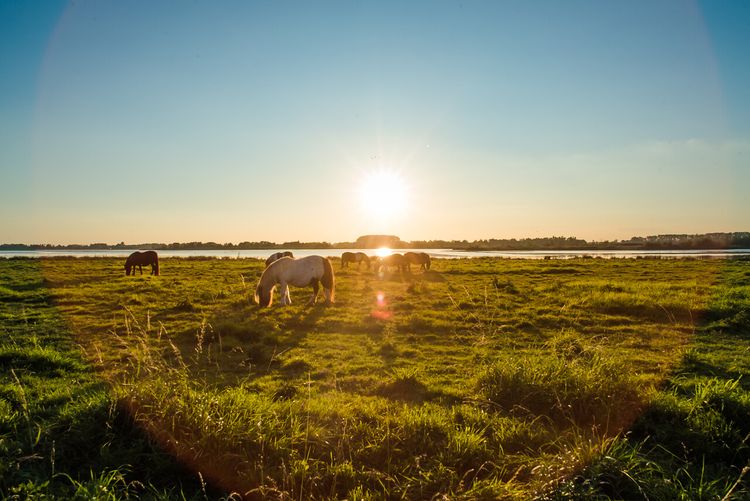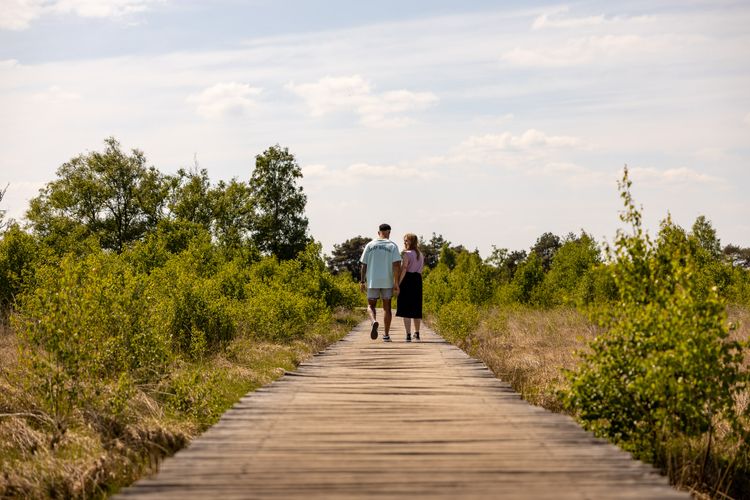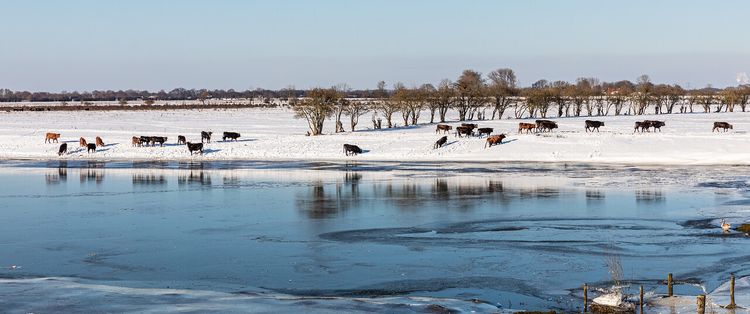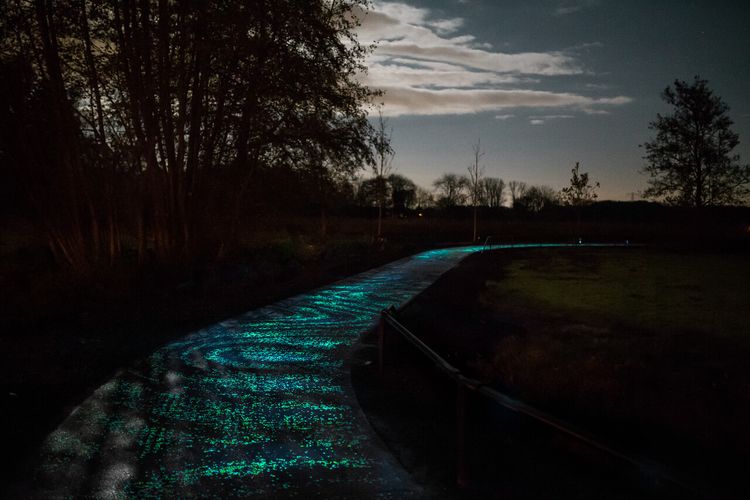Liberation route Asten
While cycling this route you will be confronted with great deeds, but also with the atrocities of war. You will pass through the area that the Allied pilots used as a refuge for planes that had been damaged by air fire.
Starting point: from your location
Show all 4 photos
Death Valley De Peel
While cycling this route you will be confronted with great deeds, but also with the atrocities of war. You will pass through the area that the Allied pilots used as a refuge for planes that had been damaged by air fire. This area, De Peel, was nicknamed "Death Valley". On this route you can visit a museum farm where an British Field Marshal once stayed. You will also cycle past the castle that came under fire after the liberation. Along the way you will learn all about the defences of both the Dutch and the German armies.
-
Signposting Liberation Route Brabant
Follow the signs with 'Liberation Route'. These are hung below the regular junction signs.
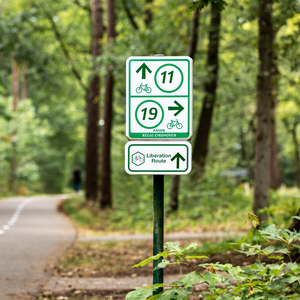
Signposting Liberation Route Brabant
Follow the signs with 'Liberation Route'. These are hung below the regular junction signs.

-
Hotline routes
Hotline routesIf there is something wrong on the route, report it here.
Sights on this route
Museum Klok & Peel
Museum Klok & Peel shows in a unique way how the Groot Peel National Park, a nature reserve bordering the Dutch provinces of Brabant and Limburg, has developed in the past ten thousand years.
Starting point:
Ostaderstraat 235721 WC Asten
Navigate to starting point

Villa Bluijssen
This villa, located on the corner of Julianastraat and Koningsplein, played an important role both at the beginning and at the end of the war. Many commanders had their headquarters here. During the mobilization, Lieutenant Colonel Themann commanded from this location.
Starting point:
asten
Molen van Stekelenburg
Millers Frits and Ferd van Stekelenburg were surprised when soldiers of the 7th US Armored Division suddenly appeared at their mill in Asten.
Starting point:
asten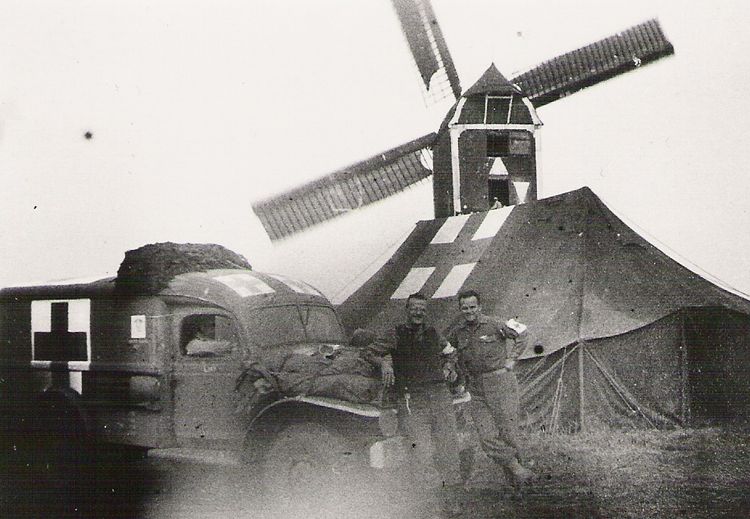
The Day Mary Didn’t Look
In the night from Wednesday 20 to Thursday 21 September 1944, Asten is in turmoil. British shellfire causes major destruction in and around the church.
Starting point:
asten
Starting point:
asten
Museum War and co
All kinds of stuff about WWI and WWII, mainly about Vlierden.
Starting point:
Museum Oorlog en CoSchooteindseweg 24
5756 PG Vlierden
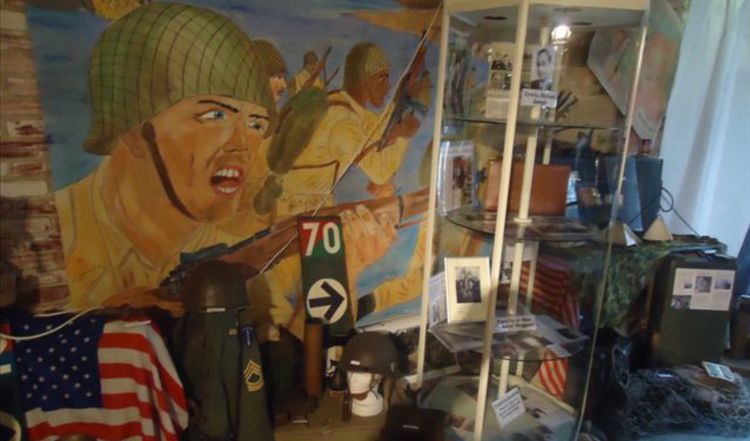
Starting point:
Monseigneur Berkvensstraat 83A5757 BJ Liessel
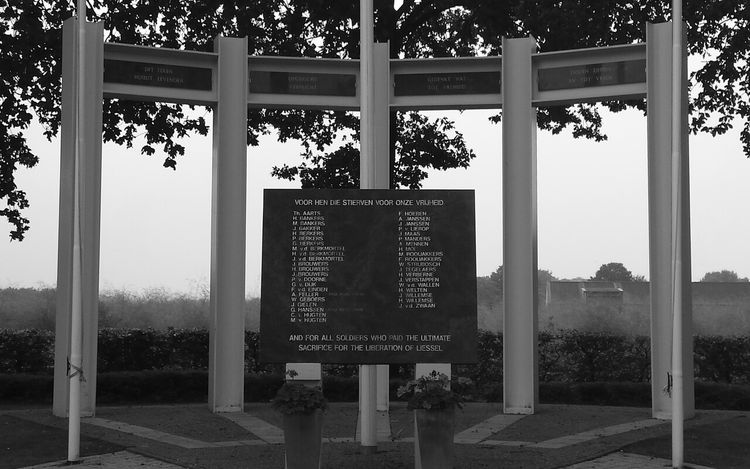
Starting point:
Neerkant
Starting point:
Neerkant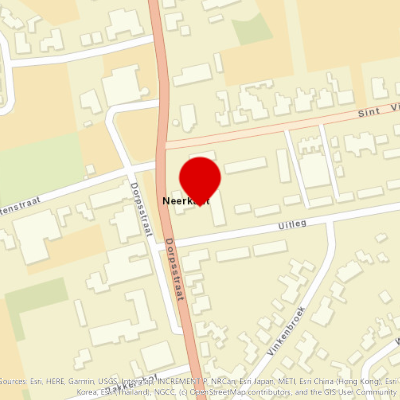
Starting point:
Meijel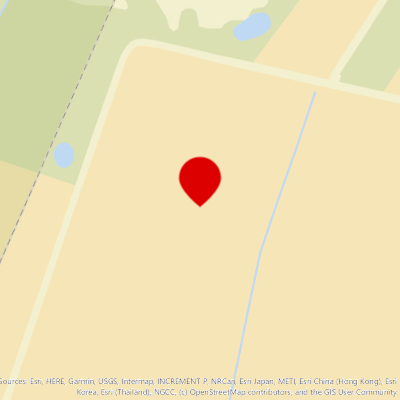
Starting point:
Meijel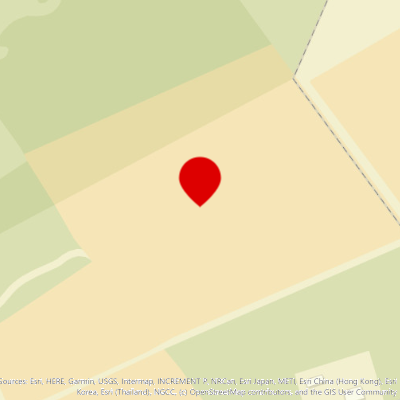
Starting point:
Ospeldijk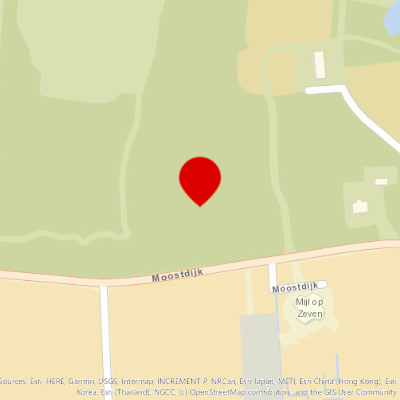
Starting point:
Witte Bergen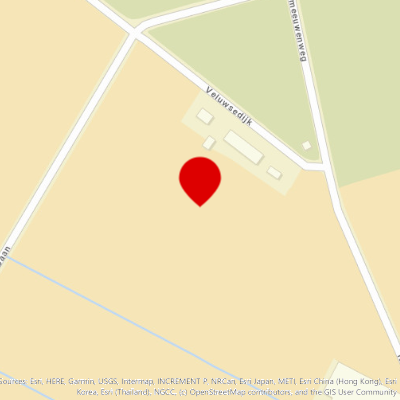
Wehrmacht house
In the middle of the fields between the forest and the Eeuwselse Loop path there is a small building: the remains of a so-called Wehrmacht house. These houses were part of the German air defence line against the allied bombers: the Kammhuber line.
Starting point:
Kerkendijk5712EW Someren

Castle Asten
A number of Dutch noble families such as Van Cuyck and Van Brederode are connected to the fifteenth-century castle in Asten-Heusden. In the '30s, the castle was in a dilapidated state. Baron Clemens Ernest Alexander van Hövell van Westervlier and Weezevel
Starting point:
Kasteellaan 15725 AD Heusden Gem Asten
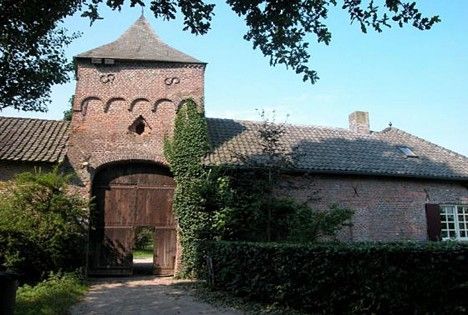
Museum Klok & Peel
Museum Klok & Peel shows in a unique way how the Groot Peel National Park, a nature reserve bordering the Dutch provinces of Brabant and Limburg, has developed in the past ten thousand years.
Starting point:
Ostaderstraat 235721 WC Asten
Navigate to endpoint

Story of the route
Museum Klok & Peel
Museum Klok & Peel shows in a unique way how the Groot Peel National Park, a nature reserve bordering the Dutch provinces of Brabant and Limburg, has developed in the past ten thousand years.
Starting point:
Ostaderstraat 235721 WC Asten
Navigate to starting point

- Museum Klok & Peel
On this spot once stood the farm of Johannes Leenders and Johanna van den Eijnden. In the autumn of 1944, British Field Marshal Bernard Montgomery used this address as one of his secret lodgings. Now, Museum Klok & Peel (Clock & Peel) is located here. As the name suggests, the museum focuses on two themes: clocks, and the natural and cultural history of De Peel. - Villa Bluijssen
This villa, on the corner of Julianastraat and Koningsplein, played an important role both at the beginning and at the end of the war. Many commanders had their headquarters here. During the mobilisation, Lieutenant Colonel Themann used it as his base of command. - Windmill at Stekelenburg
Millers Frits and Ferd van Stekelenburg must have been surprised when a number of soldiers from the 7th US Armoured Division suddenly appeared next to their windmill in Asten. The soldiers set up a field hospital next to the mill. It was so close to the mill, in fact, that it had to be moved a bit, so that the structure wouldn't get hit by the sails. The windmill was an unusual sight for the British and American soldiers. They would visit the mill and forget about the war, just for a little while. - The day Mary was not watching
In the red block you can read an excerpt from the tragic story of the Klaus and Michiels families. View the complete story in the Brabant Remembers Living History App. - The last cavalry charge
Janus Loomans was in hiding at home in the hamlet of Ommelse Bos. On the morning of 22 September 1944 he thought he was dreaming. He saw about seventy German soldiers passing by on horseback, led by the fanatical one-armed Major Heinrich Hoffer. What Major Hoffer did not know was that the British had dug in their tanks between Asten and Ommel: the Germans were riding to their demise. Janus witnessed the inglorious downfall of the once so proud German cavalry. About forty horses and riders lost their lives in a barrage of machine gun fire. - War Memorial Liessel
The 'Battle in the Shadow’ (Slag in de Schaduw), described by A. Korthals Altes in his book of the same name, took place on the territory of the villages of Asten, Deurne, Nederweert, and what was then Meijel. After the 7th US Armoured Division had managed to hold out against the Germans, it was up to the 15th Scottish Division to clear the outskirts of German soldiers together with the Americans. Many hundreds of soldiers lost their lives in those battles. In addition, dozens of civilians lost their lives in the church villages of Liessel and Neerkant in Deurne. In 1992 this dignified memorial was erected in Liessel for all war victims. - Sleutels Farm
On Dolle Dinsdag (Mad Tuesday), 5 September 1944, an unprecedented liberation fever spread across the southern Netherlands. Reports that the end of the war was approaching also provoked reactions that had a counterproductive effect on the festive mood. For example, an act of revenge on a fleeing SS officer by a young man who had been in hiding caused eight German soldiers to retaliate. The Berkvens brothers were arrested and beaten up. The Germans also threatened to set fire to the entire village, but in the end they only burned down Sleutels farm; the hiding place of the young man. - Neerkant Sacrifice
During the mobilisation in 1939, Dutch soldiers were billeted in Neerkant. They were ordered to build concrete bunkers as part of the Peel-Raam line. On May 10, 1940, these structures were supposed to prove their usefulness. By 11:00 a.m., on the orders of the military, several residents were told to leave their homes. The houses were then set on fire. These houses were in the field of vision of the shooting lines. But at 2 p.m. the Dutch soldiers were ordered to withdraw. They left behind a sad row of tall smoke columns and burning houses: witnesses to the sacrifice that was made for a battle that never took place. - Peel-Raam line
De Peel has always been a natural barrier between the Dutch provinces of North Brabant and Limburg. The area is difficult to pass through because of the marshes. In addition, there are natural elevations in strategic locations. Vossenberg hill was one of the most important spots. From this high sand ridge it was possible to control a large part of the flat and barren peat bog area. That's why the Ministry of Defence had a line of defences built in this area with bunkers, trenches and minefields: the Peel-Raamstelling (Peel-Raam line). The people in charge thought they had built a good stronghold, but the village of Mill was captured as early as 10 May 1940. This made the defence line worthless. The troops were ordered to give it up. They left the Vossenberg stronghold without having fired a shot. - Battle for De Peel
Most of the villages in De Peel were liberated by mid-October 1944, but the Groote Peel area remained a no man's land. On 27 October 1944, some 11,000 German troops stationed at Meijel attacked their enemy in the direction of Asten and Deurne. They were met with dogged American and Scottish combat units, which counter-attacked with large equipment around 1 November. Tanks got stuck in the swampy areas of De Peel, and infantrymen got caught up in grim hit-and-run battles under air support. The material losses were enormous. On 6 November the Germans brought down a Canadian Mustang on Amsloberg hill. As late as August 2017, remains of this aircraft were still found. On 17 November 1944, Meijel was finally liberated, but it was completely destroyed. - Pilot monument
This monument is located in a place known for its importance to fighter pilots. Allied pilots sought out dark and sparsely populated areas such as De Peel as a refuge for their damaged planes, for a better chance of survival. The area was quickly nicknamed 'Death Valley'. Dozens of planes crashed in and around De Groote Peel. Many Allied airmen were killed in the process. Since 2002, the sacrifice of these airmen has been honoured with a monument near the Meerbaan. - Double crash
At least sixteen pilots died in the immediate vicinity of Asten as a result of airplane crashes. On 7 February 1945, two Halifaxes came down at the same time in a double crash. In one of the planes, the bombs on board exploded on impact. The explosion created a large crater, and of the three crew members who died, two bodies could never be recovered. An oak memorial cross was erected for them. - Wehrmacht house
In the middle of the fields between the forest and the Eeuwselse Loop path there is a small building: the remains of a so-called Wehrmacht house. These houses were part of the German air defence line against the allied bombers: the Kammhuber line. Since 2013 the house has been renovated and converted into a mini-museum. Please make an appointment if you would like to go inside. - Children playing soldiers
In the autumn of 1944, many British soldiers were quartered in Heusden. For the local children, playing soldiers became a favourite activity. The outlying area had to deal with a lot of violence, including a major German counter-attack in October 1944. Several Heusden residents lost their lives in that attack. The names of the local victims are honoured on a war memorial in front of the St. Anthony of Padua's Church on Vorstermansplein square. - Castle Asten on fire
A number of Dutch noble families such as Van Cuyck and Van Brederode are connected to the fifteenth-century castle in Asten-Heusden. In the '30s, the castle was in a dilapidated state. Baron Clemens Ernest Alexander van Hövell van Westervlier and Weezeveld started restoration works in 1935. His daughter lady Elisabeth and son-in-law Alexander van der Heyden moved in in 1941. They were forced to flee during the liberation. In the early morning of 5 October 1944, after the liberation, a German patrol set fire to the castle with phosphorus shells. - Lock 11
The drawbridge between Asten and Someren was located at Lock 11 on the Zuid-Willemsvaart canal. During the Second World War this place was of strategic importance. On 21 September 1944, Major General George 'Pip' Roberts wanted to cross the canal with two brigades of the British 11th Armoured Division. However, Oberst Ramoth of the Grenadier-Ersatz and Ausbildungs-Regiment 269 blew up the bridge. Under heavy artillery fire, a Bailey bridge was set up on the night of 22 September. Tank commander Don Bulley led the attack the next morning with the cry "We're off!" He was killed a few minutes later. - Museum Oorlog en Co
In 2008 Wils Verberne, then only twelve years old, opened the war museum Oorlog en Co (War and Co) at De Schooteindhoeve farm. In addition to many objects from the Second World War, you'll find a suitcase that belonged to Erwin Michael Joseph. This Jewish boy was murdered by people smugglers in the woods near Vlierden. The museum is open by appointment. - The day Mary was not watching
There was a ghostly atmosphere in Asten in the night of Wednesday 20 to Thursday 21 September 1944. That night, British shellfire caused great havoc in and around the church. The following day, Asten was evacuated, and in the evening so was church village Ommel, a popular pilgrimage site. The Germans had warned them: “Das ganze Heiligtum geht kaputt.” (All this sacred ground is going to be destroyed.) Many Ommel residents decided to leave, but many others chose to stay.
The families Klaus and Michiels, each blessed with many children, were faced with the choice to leave Ommel or to stay. There was heavy fighting all around. They decided to stay in the farms at the Ommels Eindje for one more night. The families shared a shelter: a deep ditch between the farms, with straw on the bottom and a provisional covering of branches tied together on top. The children sometimes used the shelter as a playhouse. Both families got ready for a night in the shelter. After some grumbling about who should go where, most of the night was spent lying awake. The families made it through the night and woke up to a new day of war. On this day, the battle between the British and the tormented Germans came to a climax. Grenades flew over the houses. One of them hit one of the two thick linden trees directly behind the shelter. Dora Michiels was eight years old. For fifty years, she couldn't talk about the disaster that happened in the seconds that followed.
Museum Klok & Peel
Museum Klok & Peel shows in a unique way how the Groot Peel National Park, a nature reserve bordering the Dutch provinces of Brabant and Limburg, has developed in the past ten thousand years.
Starting point:
Ostaderstraat 235721 WC Asten
Navigate to endpoint

- 23
- 42
- 46
- 01
- 50
- 47
- 43
- 44
- 89
- 45
- 20
- 95
- 08
- 07
- 05
- 94
- 70
- 87
- 83
- 82
- 65
- 81

